Abstract
The objective of the present study was to investigate the effects of different packaging methods and storage time on the quality and shelf life extension of beef steaks (M. longissimus dorsi). Steaks were packed under air (control), vacuum, MAP1 (60:40/O2:CO2) and MAP2 (60:20:20/O2:CO2:N2) conditions. Packed steak samples were stored at 4 ± 1 °C for 35 days. Physical, chemical (headspace gas analysis, weight loss, water holding capacity, Warner-Bratzler shear force, instrumental color measurement, pH, thiobarbituric acid reactive substances (TBARS), myoglobin content) and sensory color analyses were performed. It was determined that vacuum packaging reduced the weight losses during the storage. In terms of sensory color evaluation, the best results were observed in vacuum packed samples. TBARS values were increased in all samples during the storage time. In terms of lipid oxidation level, it was defined that vacuum packed samples might provide the longest shelf life. Interaction of packaging method and storage time affected the shear force values significantly (P < 0.001). The interaction of packaging method and storage day affected the L*, a*, b* values of the beef steaks significantly (P < 0.001).
El objetivo del presente estudio consistió en investigar los efectos que distintos métodos de empacado y el tiempo de almacenamiento tienen sobre la calidad y la extensión del periodo útil de bistecs de res (M. longissimus dorsi). Para ello se empacaron varias muestras de bistecs de res en las siguientes condiciones: La muestra control al aire y las restantes muestras al vacío: MAP1 (60:40/O2:CO2) y MAP2 (60:20:20/O2:CO2:N2). Dichas muestras fueron almacenadas a 4 ±1 °C durante 35 días. Posteriormente, se realizaron los análisis fisicoquímicos que se mencionan a continuación: análisis de gas en el espacio en cabeza [headspace], pérdida de peso, capacidad de retención de agua, fuerza de corte Warner-Bratzler, medición instrumental de color, pH, thiobarbituric acid reactive substances (TBARS), contenido de mioglobina, así como evaluación sensorial de color. A partir de estos análisis se determinó que en la muestra empacada al vacío se redujeron las pérdidas de peso ocurridas durante el almacenamiento. En cuanto a la evaluación sensorial de color, los mejores resultados se observaron en las muestras empacadas al vacío. Asimismo, se constató que durante el tiempo de almacenamiento aumentaron los valores Tbars de todas las muestras. En términos del nivel de oxidación de lípidos, se concluyó que las muestras empacadas al vacío podrían tener la vida útil más larga. La interacción entre el método de empaque y los días de almacenamiento afectó significativamente los valores L*, a* y b* de los bistecs de res (P < 0,001).
Introduction
In recent years, retail sales of portioned and packed fresh meat in shopping centers have become gradually widespread, revealing an economical possibility of desirable quality and amounts. Therefore, in the last years, retail sales of meat gradually increase in shopping centers in Turkey (Çelik, Citation1993; Göktan, Citation1990).
Nowadays, consumers demand safe, additive-free and high nutritional value food. In this sense, packaging in modified atmospheres allows longer shelf life as well as attractive presentation (Lopez-Rubio, Gavara, & Lagaron, Citation2006). It is well known that packaging makes food more convenient and gives the food greater safety assurance from microorganisms, biological and chemical changes so that the packaged foods may have longer shelf life (Skandamis & Nychas, Citation2002). Packaging fresh meat is carried out to delay spoilage, permit some enzymatic activity to improve tenderness, reduce weight loss and where applicable and to ensure an oxymyoglobin or cherry red color in red meats at retail (Kerry, Kerry, & Ledward, Citation2002). Vacuum packaging and modified atmosphere packaging are effective means of prolonging the storage life of perishable foods (Rodríguez-Calleja, Santos, Otero, & García-López, Citation2010)
The increased globalization of food markets often results in long distances between production and commercialization areas (Samuela et al., Citation2011). Modified atmosphere packaging (MAP) has become a commercial and economic reality in markets that have a well-established and controlled cold chain and which can sustain a high priced quality product (Ohisson & Bengtsson, Citation2002). MAP food products reflecting increase in customer demand for longer shelf life and less use of preservatives. MAP techniques are now used on a wide range of fresh and chilled foods, including raw and cooked meats and poultry (Phillips, Citation1996).
Among the packaging technologies developed by and for the food industry, modified atmosphere packaging has led to the evolution of fresh and minimally processed food preservation, specially in meat and meat products for the past three decades (Skandamis & Nychas, Citation2002).
Common gases used in MAP are carbon dioxide, oxygen and nitrogen. These gases are applied individually or in combination in order to achieve optimum effect. Functions of oxygen are to prevent anaerobic growth and to maintain myoglobin in its oxygenated form (oxymyoglobin); function of carbon dioxide is to inhibit the growth of aerobic spoilage bacteria and nitrogen functions are as a filler gas and to maintain package shape (Zakrys, Hogan, O’Sullivan, Allen, & Kerry, Citation2008; Zakrys, O’Sullivan, Allen, & Kerry, Citation2009).
The objectives of this study were to investigate the effects of different packaging methods (air (control), vacuum, 60:40/O2:CO2 (MAP1) and 60:20:20/O2:CO2:N2 (MAP2)) and storage time (1, 5, 10, 15, 20, 25, 30, 35 days) on the physicochemical and sensory color evaluation of beef steaks stored at 4 ± 1°C.
Materials and methods
Packaging of material and design of experiments
Beef steaks, M. longissimus dorsi muscle, were obtained from a local slaughterhouse in Manisa. Muscles were cut into uniform ~2.5-cm-thick steaks. Four treatments were performed as: (1) control, (2) vacuum packaging, (3) MAP1 (60% O2: 40% CO2) and (4) MAP2 (60% O2: 20% CO2: 20% N2). Control samples were packed under air conditions and heat sealed. Vacuum packed samples were placed in coex PA/PE bags and heat sealed. MAP1 samples and MAP2 samples were placed in polyethylene trays and placed in coex PA/PE bags and heat sealed using a packaging unit (Original Henkelman Vacuum Systems 200) equipped with a gas mixer (Elit KM 60–3 Witt-Gasetechnik). The oxygen transmission rate of packaging material was 3 cm3/m2/24 h (24°C). Prior to the packaging, one piece of liquid absorbent pad was placed under all of the samples. The packed samples for all treatments were stored at 4°C during 35 days. Physical, chemical and sensory color evaluations of samples were analyzed on 1, 5, 10, 15, 20, 25, 30, 35 days of storage period. All analyses were performed in Celal Bayar University, Department of Food Engineering Laboratories. The analyses were replicated twice.
Physical analyses
Head space gas analysis
Gas compositions in MAP packages were measured during storage by Oxybaby* gas analyzer WITT-GASETECHNIK GmbH & Co. KG, Germany. It was measured by directly sinking the needle into package. O2 % and CO2 % were monitored by digital screen.
Weight loss
Weight loss was measured by weighing each sample before packaging and on each experiment day during the storage period. The difference between weights was divided by the initial weight of sample and multiplied by 100. Weight loss was calculated in % (Taylor, Down, & Shaw, Citation2007).
Water holding capacity
Water holding capacity was determined by applying filter paper compression method (Vural & Öztan, Citation1996).
Warner-Bratzler shear force
Steaks were cooked to an internal temperature of 75°C in water bath and chilled to 25°C. Beef steaks were cut individually and parallel to muscle fibers as strips measuring 1×1×4 cm. For determination of shear force values, the TA.XT Plus Texture Analyzer (Stable Micro Systems Godalming, England) with 50 kg load cell was used. Warner-Bratzler shear force blade was used. Beef strips were cut into two equal pieces. Pre-test speed, test speed and post-test speed were 1 mm/sec, 2 mm/sec and 2 mm/sec, respectively (Pearson & Dutson, Citation1999).
Instrumental color measurement
The surface color measurements were carried out using a Minolta CR 300 reflectance colorimeter (Minolta Camera Co. Ltd., Osaka, Japan). CIE L*, a*, b* color values were measured (L*: lightness; a*: redness, b*: yellowness). The chroma meter was calibrated on the Hunterlab color space system using a white tile (C: Y = 93.6, x = 0.3130, y = 0.3193) (Minolta calibration plate). Six readings were taken per sample on each measurement day after opening the packages. Vacuum packed samples were exposed to atmospheric conditions in blooming time. Color measurement was performed immediately after opening the control and MAP samples.
Chemical analyses
pH
The pH was determined by blending 10-g sample with 100-mL distilled water for 2 min. The pH of the homogenate was measured at room temperature (25°C) using a pH meter (Hanna Instruments model HI 221, USA) calibrated with buffer solutions pH 4.01 and pH 7.00. Arithmetic means were calculated from four measurements (AOAC, Citation1984).
Thiobarbituric acid reactive substances (TBARS) value
Lipid oxidation level of samples was assessed by measuring 2-thiobarbituric acid reactive substances (TBARS) method. After sample preparation steps, 10-g sample was reacted with TBARS. Absorbance values were evaluated by using Schimadzu UV-1601 Spectrophotometer (Japan) at 538 nm wavelength (Vural & Öztan, Citation1996).
Myoglobin measurement
For the determination of myoglobin amount, color components showed protein characteristics in meat products were passed through water, separating the other color components except myoglobin using lead acetate and the chemical addition which provided the color stability in buffer solution. The method was based on spectrophotometric measurement (Vural & Öztan, Citation1996).
where A: absorbance value;
a = molar extinction coefficient (11.5 for myoglobin);
b = thickness of bathtub used in spectrophotometer;
c = myoglobin concentration.
Sensory color analysis
Sensory color evaluation was performed by six trained panelists; 9-point scale was used for the evaluation. Panelists evaluated the surface color of steak samples. The scales are included 1 = extremely pale, 2 = very pale, 3 = pale, 4 = slightly pale, 5 = bright red (typical fresh red meat color), 6 = slightly dark, 7 = dark, 8 = very dark and 9 = extremely dark.
Trial plan and statistical analysis
Trial plan was performed in duplicate and completely randomized factorial design (8x4) was used to analyze the data. Factors were storage time (on days 1, 5, 10, 15, 20, 25, 30 and 35) and packaging methods (aerobic, vacuum, MAP1, MAP2). Statistical analysis was carried out with the Statistical Analysis System (SAS) by using PROC GLM and PROC MIXED procedures (SAS Institute Inc., Citation1999).
Results and discussion
Headspace composition
The headspace compositions in control (air) and MAP stored samples were presented in . Values were almost constant during storage. Slight decreases were determined during the storage period. The initial O2 level of control samples was 20.28% and decreased to 16.65% at the end of the storage. O2 level of control samples was 20.28% and showed similarity with O2 concentration in air atmosphere (20.96%). This similarity shows that control samples were stored under atmospheric conditions. The initial O2 level of MAP1 samples in headspace was 58.75% and decreased to 56.65% at the end of storage. O2 levels of control samples and modified atmosphere packaging samples in headspace showed similar decrease ratios during the storage period. The highest decrease ratio was observed in MAP2 samples on 25th day of storage period as 7.13%. The effect of packaging method and storage time interaction on the O2 level changes was significant (P < 0.001). The reason of decreases in control samples and modified atmosphere packaging samples containing O2 levels in package might be explained as respiratory of product, the use of oxygen by microorganisms and the transmission of gases by packaging material (Jeremiah, Citation2001).
Table 1. Head space gas compositions of beef steak samples stored for 35 days at 4°C.
Tabla 1. Composición de gas en el espacio en cabeza de las muestras de bistec de res almacenadas durante 35 días a 4°C.
The initial CO2 level of control samples was determined as 1.15% on the first day and reached to 5.45% at the end of the storage period. Analysis of variance showed that interaction of packaging method and storage time affected the increase in CO2 level significantly (P < 0.001). The headspace was dynamic. CO2 dissolves in the meat and is formed by tissue and bacterial respiration, with the consumption of O2 (Gill, Citation1996). As mentioned before, the solubility of CO2 gases in meat and meat products was remarkably high. Additionally, it was defined that stability was remarkably difficult to attain within gas composition inside packages during the storage period (Jeremiah, Citation2001).
The initial CO2 levels of MAP1 and MAP2 samples in headspace were 37.98% and 21.65% and decreased to 36.25% and 16.58% at the end of the storage period, respectively. The most considerable change in CO2 level was observed in MAP2 samples on the 25th day. The decrease in CO2 was 4.45%. It was determined that interaction of packaging method and storage time affected the decrease significantly (P < 0.001). It might be a result of solubility of CO2 in meat. All of the changes which occurred in atmospheric composition during the storage period resulted due to the permeability of the packaging material (Jeremiah, Citation2001). Thus, Doherty, Sheridan, Allen, McDowel, and Blair (Citation1996) examined gas compositions of lamb primals packaged under vacuum and three modified atmospheres (80% O2/20% CO2, 50% CO2/50% N2 or 100% CO2) and stored at 5 or 0°C for up to 28 days and found minor changes in gas compositions over storage. As a result, changes were observed in gas compositions at low degrees. Bingöl and Ergun (Citation2011) investigated the effects of various concentrations of O2/CO2 in modified atmosphere packaging on the microbiological quality and shelf life of ostrich meat. They reported that headspace gas composition values were almost constant during storage, only a slight shift was observed after 10 days of storage under MAP conditions.
Weight loss (%)
Changes in weight loss (%) values of beef steaks stored under different packaging methods during storage were shown in . In all samples, weight loss values increased during the storage. The lowest weight loss value was observed in vacuum packed samples on the first and 35th day (). Interaction of packaging method and storage time affected weight loss values significantly (P < 0.001). This study was supported by the previous findings by Seideman and Durland (Citation1983) who determined that the weight loss of vacuum packed samples was low compared to samples packed under aerobic and modified atmosphere conditions at the end of the 20 days. Stiles (Citation1990) reported similar results; he defined that vacuum packaging prevented the weigh losses related to evaporation more than modified atmosphere packaging. In parallel with the results of the present study, Taylor et al. (Citation2007) determined that weight loss observed in vacuum packed beef samples was lower than modified atmosphere packed samples. Similarly, Lund, Lametsch, Hviid, Jensen, and Skibsted (Citation2007) determined that weight loss of fresh meat stored at high oxygen atmosphere increased gradually. Correspondingly, water holding capacity decreased gradually in the present study. Also, Hermansen (Citation1983) assessed that vacuum packed meat had a significant reduction in drip loss compared to MA packed meat.
Figure 1. Changes in weight loss (%) values of beef steaks stored under different packaging methods during storage.Standard error of mean (SEM) = 0.5336
Figura 1. Cambios en los valores de pérdida de peso (%) ocurridos durante el almacenamiento de los bistecs de res almacenados utilizando distintos métodos de empacado.
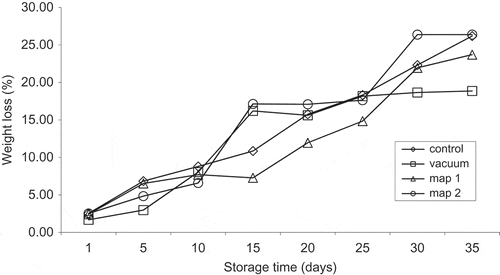
Water holding capacity
Changes in water holding capacity values of beef steaks stored under different packaging methods during storage were presented in . While the initial water holding capacity values observed in vacuum, MAP1, MAP2, control samples as 0.279, 0.353, 0.307, 0.402, respectively; these values decreased to 0.152, 0.200, 0.147, 0.234 on the 35th day (). The effects of the packaging method and storage day on water holding capacity values were statistically significant (P < 0.001). However, interaction of packaging method and storage time affected water holding capacity values insignificantly (P > 0.05).
Figure 2. Changes in water holding capacity values of beef steaks stored under different packaging methods during storage.Standard error of mean (SEM) = 0.0245
Figura 2. Cambios en los valores de la capacidad de retención de agua ocurridos durante el almacenamiento de los bistecs de res almacenados utilizando distintos métodos de empacado.
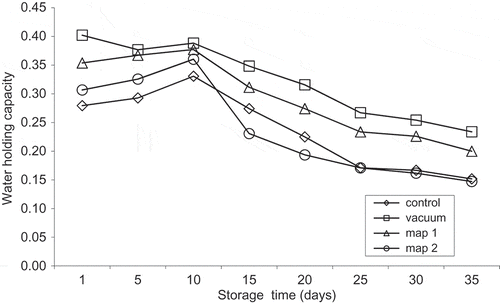
The highest water holding capacity was observed in vacuum packed meat samples at the first day of storage (). In this study, it was determined that while water holding capacity values decreased in all samples; weight loss increased during the 35 days of storage period. Water holding capacity values of control, MAP1 and MAP2 samples were observed to be lower than vacuum packed samples at the end of the storage (). This supports that vacuum packaging decreased weight loss. Additionally, it was reported that CO2 in MA packages decreased pH level of meat and led to denaturation of surface proteins and decrease the water holding capacity considerably (Üçüncü, Citation2007). So that in this study, the pH values of MAP samples were lower than control samples among 25th and 35th days.
Warner-Bratzler shear force values
Changes in Warner-Bratzler Shear Force values of beef steaks stored under different packaging methods during storage were shown in . While Shear Force values of control, MAP1, MAP2 and vacuum samples were 3.93 kg, 2.36 kg, 3.44 kg and 3.09 kg, respectively, at the beginning of the storage period. These values increased to 5.50 kg, 2.55 kg, 4.35 kg and 3.19 kg, respectively (). Interaction of packaging method and storage time affected the shear force values significantly (P < 0.001).
Figure 3. Changes in Warner-Bratzler Shear Force values of beef steaks stored under different packaging methods during storage.Standard error of mean (SEM) = 0.5597
Figura 3. Cambios en los valores de fuerza de corte Warner-Bratzler ocurridos durante el almacenamiento de los bistecs de res almacenados utilizando distintos métodos de empacado.
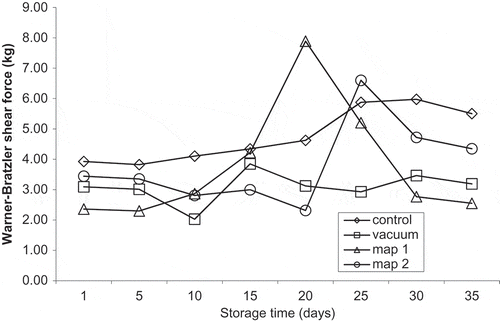
The maximum increase ratio of shear force was observed in control samples during the storage period (). The increase ratio of shear force in control samples was higher than other samples. In this case, it might be explained that the structure of the vacuum packed samples were harder than the other samples. Under anaerobic conditions, softening might be related to autolytic activities, which during prolonged chilled storage tenderize the meat, and ultimately degrade the texture of muscle tissue (Rodríguez-Calleja et al., Citation2010) and the lowest shear force value was observed in the MAP1 samples. Therefore, MAP1 samples were softer than the others. It might be resulted from the high level of water holding capacity and low level of weight loss. Furthermore, it was defined that lipid oxidation led to the changes in texture attributes of fresh meat (Kerry et al., Citation2002). Thus, in the present study, TBA values of MAP1 samples were lower than the control and MAP2 samples. Mullan and McDowell (Citation2003) explained that microbial growth causes to the changes in texture attributes of fresh meat.
Fernandes et al. (Citation2014) assessed lamb lions stored under refrigeration (1 ± 1°C) and packed in different MAP conditions (vacuum, 75% O2 + 25% CO2 and 100% CO2 for 28 days. In contrast to the present study, they reported that there was no significant difference in tenderness of the lamb lions between the treatments. Also, no interaction was observed between the storage time and the treatment groups.
pH
Changes in pH values of beef steaks stored under different packaging methods during storage were shown in . In the present study, initial pH values of samples were between 5.54 and 5.57 and were increased to between 6.22 and 6.61 values at the end of the storage period (). Thus at the end of the ripening period of meat, pH values of meat generally changes between 5.6 and 6.2 (Öztan, Citation2003). It was defined that when pH reached above 6.2; fresh meat begins to deteriorate. pH values of samples regularly showed an increase during the storage period. Interaction of packaging method and storage day affected the pH values significantly (P < 0.001).
Figure 4. Changes in pH values of beef steaks stored under different packaging methods during storage.Standard error of mean (SEM) = 0.0157
Figura 4. Cambios en los valores de pH ocurridos durante el almacenamiento de los bistecs de res almacenados utilizando distintos métodos de empacado.

When critical pH level was considered primarily, pH values of control samples were 6.16 on day 25; pH values of MAP1 and MAP2 samples reached to 6.33 and 6.32 on day 35. Vacuum packaging samples reached to 6.22 pH value on day 35. While the minimum pH values of samples were observed in vacuum packed samples; the maximum pH value was determined in control samples. Okayama (Citation1987) determined that the surface pH of beef steaks packed under 80% O2 +20% CO2 stored at 4°C increased significantly during 13 days of the storage period. At that point, pH values of MAP1 and MAP2 samples were lower than control samples, which could be attributed to CO2 gas ratios in MA packages since CO2 led to the decrease of pH by dissolving in meat.
Thiobarbituric acid reactive substances (TBARS) values
The oxidative stability of beef steaks stored under different packaging methods during storage was shown in . Initial TBARS values were determined as 0.142, 0.144, 0.183 and 0.159 mg MA/kg for control, MAP1, MAP2 and vacuum samples, respectively. At the end of the storage period, TBARS values increased to 0.810, 0.680, 0.689, 0.586 mg MA/kg, respectively (). This study is in agreement with the previous study of Zakrys et al. (Citation2009) who reported that the oxidation of lipids in beef steaks increased with shelf life. Results of this study show that TBARS levels of all samples were determined below the limit of 1 mg/kg meat. Tarladgis, Watts, Younathan, and Dugan (Citation1960) reported that the TBA number between 0.5 and 1.0 mg/kg was the indication of rancid odor. Interaction of packaging method and storage time affected the TBARS values significantly (P < 0.001). Fernandes et al. (Citation2014) assessed lamb lions stored under refrigeration (1 ± 1°C) and packed in different MAP conditions (vacuum, 75% O2 + 25% CO2 and 100% CO2 for 28 days. In contrast, they observed that no significant variations were detected among treatments and there were no interactions between the analyzed treatments and storage period.
Figure 5. Changes in TBARS values of beef steaks stored under different packaging methods during storage.Standard error of mean (SEM) = 0.0245
Figura 5. Cambios en los valores TBARS ocurridos durante el almacenamiento de los bistecs de res almacenados utilizando distintos métodos de empacado.
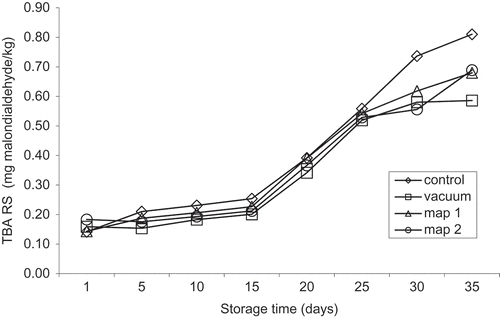
At the end of the storage, the highest TBARS value was observed in the control samples. It was determined that TBA values of MAP1 and MAP2 samples were similar to each other during the storage period. It was reported that the level of lipid oxidation was associated with the level of oxygen used in high-oxygen modified atmosphere packaging which led to shorten the shelf life by increasing lipid oxidation in meat and meat products (Kerry et al., Citation2002).
It was observed that TBARS values of vacuum packed samples were lower than the control, MAP1 and MAP2 samples. Similar findings were reported by Taylor et al. (Citation2007) who found that the amount of malondialdehyde in beef steaks packed under modified atmosphere increased rapidly more than vacuum packed steaks during storage. Additionally, Jackson, Acuff, Vanderzant, Sharp, and Savell (Citation1992) reported that lipid oxidation level of beef steaks packaged under 80% O2 and 20% CO2 gas mixture and stored at 3°C increased rapidly.
Murphy, O’Grady, and Kerry (Citation2013) evaluated the effects of varying the gas headspace to meat ratio on the quality and shelf life of beef steaks packaged in high oxygen modified atmosphere packs. They found that lipid oxidation increased over time in beef steaks packaged in all treatments. Levels of lipid oxidation remained low in vacuum packaged beef steaks throughout the storage period. These findings are in agreement with the present study.
At the end of storage time, it was determined that TBARS value of MAP1 sample was lower than control and MAP2 samples (). In another study, Lopez-Lorenzo, Hernandez, Sanz-Perez, and Ordoñez (Citation1980) determined that 20% CO2 inside package decelerated lipid oxidation of pork meat. Additionally, Jakobsen and Bertelsen (Citation2002) reported that CO2 decreased lipid oxidation rate in meat and this was attributed to pH reduction due to the absorption of CO2.
TBARS values of control samples and MAP samples were remarkably different from each other. In contrast to the results obtained in this study; Ordonez and Ledward (Citation1977) stated that the stability of lipid oxidation of meat products packed in 80%, 90% and 100% oxygen were very similar to each other.
Myoglobin
Changes in myoglobin concentration of steak samples during storage were shown in . On the first day, when the myoglobin concentrations of the control, MAP1, MAP2, and vacuum samples were 1.95, 1.92, 1.89, 1.16 mg/g, respectively; on the 35th day, these values decreased to 1.63, 1.30, 1.05, 1.12 mg/g, respectively. It was determined that interaction of packaging method and storage day affected the myoglobin concentrations significantly (P < 0.05).
Figure 6. Changes in myoglobin amounts of beef steaks stored under different packaging methods during storage.Standard error of mean (SEM) = 0.1154
Figura 6. Cambios en las cantidades de mioglobina ocurridos durante el almacenamiento de los bistecs de res almacenados utilizando distintos métodos de empacado.
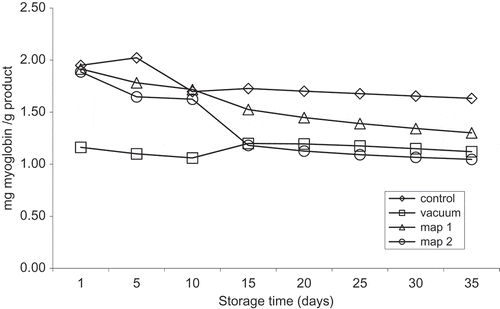
While the initial myoglobin contents of control, MAP1 and MAP2 samples were similar to each other; the values of vacuum packed samples were lower than these. At the end of the storage time, the lowest myoglobin content was found in MAP2 samples; the highest myoglobin content was found in control samples (). The reason of decrease in myoglobin concentration of vacuum packed samples can be related to the conversion of myoglobin to metmyoglobin in the absence of oxygen. On the other hand, the decrease of myoglobin concentration in MA packed samples may be caused by formation of oxymyoglobin due to the reaction of myoglobin with oxygen. Gill (Citation1996) reported that the change of color stability on fresh red meat were directly associated with oxygen concentration throughout storage time.
Instrumental surface color measurements
Changes in surface L*, a*, b* values during storage are shown in , respectively. While L* (lightness) values of the samples changed between 39.14 and 40.82 on the first day, these values were between 37.87 and 47.46 at the end of the storage time. Interaction of packing method and storage time affected the L* values significantly (P < 0.001). The lowest L* value was determined in vacuum packed samples on 15th day. The highest L* value was found in MAP2 samples on 30th day. L* values of vacuum packed samples declined during the storage. Decrease in L* values of vacuum packed samples can be caused by metmyoglobin occurring in package during the storage and cannot be completely converted to oxymyoglobin or myoglobin (metmyoglobin reducing activity) after the package is opened. L* values of control, MAP1 and MAP2 samples increased at the end of the storage. In contrast with the sensory color evaluation, the surface color of control, MAP1 and MAP2 became darker gradually during storage. The highest increase was observed in MAP2 samples caused by high O2 level in packages. Similar results were reported by Zakrys et al. (Citation2008) who determined that L* values of beef samples packed under different gas compositions (50:30:20/O2:N2:CO2 and 80:20/O2:CO2) increased during 21 days of storage at 4°C.
Figure 7. Changes in CIE L* (lightness) values of beef steaks stored under different packaging methods during storage.Standard error of mean (SEM) = 0.3818
Figura 7. Cambios en los valores CIE L* (ligereza) ocurridos durante el almacenamiento de los bistecs de res almacenados utilizando distintos métodos de empacado.
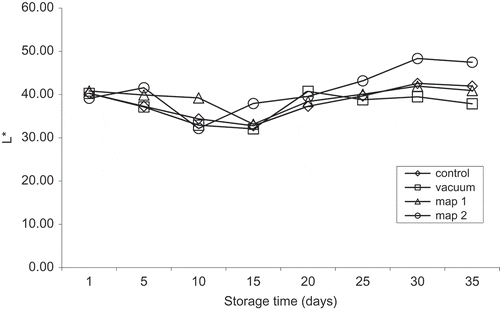
Figure 8. Changes in CIE a*(redness) values of beef steaks stored under different packaging methods during storage.Standard error of mean (SEM) = 0.5233
Figura 8. Cambios en los valores CIE a* (enrojecimiento) ocurridos durante el almacenamiento de los bistecs de res almacenados utilizando distintos métodos de empacado.
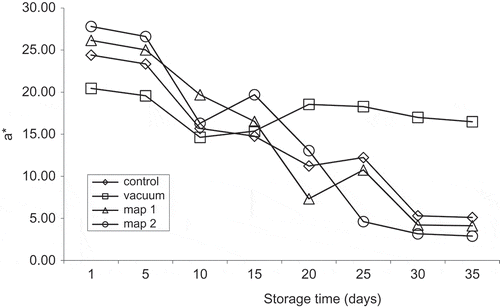
Figure 9. Changes in CIE b* (yellowness) values of beef steaks stored under different packaging methods during storage.Standard error of mean (SEM) = 0.3304
Figura 9. Cambios en los valores CIE b* (amarillez) ocurridos durante el almacenamiento de los bistecs de res almacenados utilizando distintos métodos de empacado.
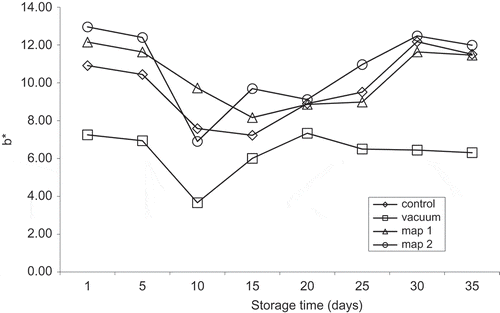
Additionally, while a*(redness) values of samples changed between 15.67 and 26.15 at the beginning of the storage and they decreased to between 4.12 and 16.86 at the end of the storage (). a* values in control, MAP1 and MAP2 samples decreased significantly (P < 0.001). Redness decreased due to oxidation of myoglobin in packed meat. Also, interaction of packaging method and storage day influenced a* values significantly (P < 0.001). At the end of the storage, the highest a* value was determined in vacuum packed samples. The redness values of vacuum packed samples were considerably different compared to other samples due to water loss. Water loss which occurred in fresh meat might have led to the excessive accumulation of myoglobin pigment on the surface of the meat. Also, CO2 was used for MAP samples. It was reported that CO2 lead to discoloration in meat products, especially grey color was observed (Üçüncü, Citation2007).
b* (yellowness) values of samples determined between 4.65 and 12.15 values on the first day of storage and were found between 5.55 and 11.51 values at the end of the storage. The interaction of packaging method and storage time significantly (P < 0.001) affected b* values of the beef steaks.
Sensory color evaluation
On the first day of the storage, the highest score was determined in vacuum packed samples. In contrast, at the end of the storage time, the lowest score was observed in vacuum packed samples. Therefore, the highest decrease in sensory color scores were observed in vacuum packed samples (). During 35 days of storage time, sensory color scores of vacuum packed samples were observed from extremely dark to slightly pale.
Table 2. Sensory color evaluation of beef steak samples stored for 35 days at 4°C.
Tabla 2. Evaluación sensorial de color de las muestras de bistec de res almacenadas durante 35 días a 4°C.
While the initial sensory score of control, MAP1 and MAP2 samples changed between 4.5 and 5.5, these values reached to 8.1–8.8 at the end of the storage time (). This indicated that color became gradually darker during the storage time. As a result of the sensory color evaluation, it was determined that MAP1 and MAP2 samples had a desirable meat color during 15–20 days at 4°C. Similar findings were reported by Okayama (Citation1987) who found that beef steaks packed under MAP (80:20/O2:CO2) preserved fresh desirable meat color during 13 days of storage at 4°C. The surface color became darker in the control, MAP1 and MAP2 samples as compared to vacuum packed samples, because of the reactions occurred in color pigments. In connection with instrumental surface color evaluation, it was determined that the redness of control, MAP1 and MAP2 samples decreased due to oxidation of myoglobin. Additionally, the increase of pigment concentration on the surface of meat might affect the infuscation of color due to water loss (Aberle et al., Citation2002). Such that, the maximum water loss (%) were observed in control, MAP1 and MAP2 samples.
Conclusions
Gas compositions in the control and MA packages changed during the storage period due to respiration, microbial activity and gas permeability of packaging material. Significant increase was observed in weight loss of all samples during storage time. The lowest weight loss value was observed in vacuum packed samples at the end of the storage. During the storage time, a significant decrease was determined in water holding capacity of all samples. When the water holding capacity of the samples decreased; weight loss values increased during storage. According to the Warner-Bratzler shear force values, it was observed that MAP1 samples were tenderer at the end of the storage which is associated with high water holding capacity and low weight loss. When pH level was considered primarily as quality criteria of fresh meat, it was determined that control samples were not suitable for consumption after 25 days, MAP1 and MAP2 samples could not be consumed after 30 days and vacuum packed samples were not appropriate for consumption after 35 days. High-oxygen atmosphere packaging shortened shelf life by increasing lipid oxidation of meat. This study showed that vacuum packaging had the most preservative effect on a* (redness) values during storage time. According to the sensory color evaluation, the most satisfactory and preferred sample group were vacuum packed samples.
The best visual quality was determined in vacuum packed samples. Additionally, reducing shrinkage was considered as a significant result in terms of commercial and economic impacts. In terms of the widespread use of packaging technology, the findings obtained from the present study play a significant role in the retail sales of fresh beef. It is essential that the developments in packaging technology should reduce the cost, provide a longer shelf life and assure food safety.
Acknowledgement
This work was supported by Scientific Research Projects Coordination Unit of Celal Bayar University. Project number is 2006-119.
References
- Aberle, E. D., Forrest, J. C., Gerrard, D. E., Mills, E. W., Hedrick, H. B., Judge, M. D., & Merkel, R. A. (Eds.). (2002). Principles of meat science (4th ed.). Dubuque, IA: Kendall/Hunt Publishing Company.
- AOAC. (1984). Official methods of analysis. Washington DC: Association of Official Analytical Chemists.
- Bingöl, E. B., & Ergun, O. (2011). Effects of modified atmosphere packaging (MAP) on the microbiological quality and shelf life of ostrich meat. Meat Science, 88, 774–785. doi:10.1016/j.meatsci.2011.03.013
- Çelik, T. H. (1993). Paketlenmiş olarak satılan taze etlerin mikrobiyolojik kaliteleri (Doctoral thesis). Institute of Health Sciences, Ankara University, Ankara.
- Doherty, A. M., Sheridan, J. J., Allen, P., McDowel, D. A., & Blair, I. S. (1996). Physical characteristics of lamb primals packaged under vacuum or modified atmospheres. Meat Science, 42(3), 315–324. doi:10.1016/0309-1740(95)00040-2
- Fernandes, R. P. P., Freire, M. T. A., Paula, E. S. M., Kanashiro, A. L. S., Catunda, F. A. P., Rosa, A. F. … Trindade, M. A. (2014). Stability of lamb loin stored under refrigeration and packed in different modified atmosphere packaging systems. Meat Science, 96, 554–561. doi:10.1016/j.meatsci.2013.08.005
- Gill, C. O. (1996). Extending the storage life of raw chilled meats. Meat Science, 43, 99–109. doi:10.1016/0309-1740(96)00058-7
- Göktan, D. (1990). Gıdaların mikrobiyal ekolojisi. Et mikrobiyolojisi cilt 1. İzmir: Ege Üniversitesi Basımevi.
- Hermansen, P. (1983). Comparison of modified atmosphere versus vacuum packaging to extend the shelf life of retail fresh meat cuts, Proceedings Annual Reciprocal Meat Conference of the American Meat Science Association: 6th, Chicago, 35, 60–64.
- Jackson, T. C., Acuff, G. R., Vanderzant, C., Sharp, T. R., & Savell, J. W. (1992). Identification and evaluation of volatile compounds of vacuum and modified atmosphere packaged beef strip loins. Meat Science, 31, 175–190. doi:10.1016/0309-1740(92)90037-5
- Jakobsen, M., & Bertelsen, G. (2002). The use of CO2 in packaging of fresh red meats and its effect on chemical quality changes in the meat: A review. Journal of Muscle Foods, 13, 143–168. doi:10.1111/j.1745-4573.2002.tb00326.x
- Jeremiah, L. E. (2001). Packaging alternatives to deliver fresh meats using short-or long-term distribution. Food Research International, 34(9), 749–772. doi:10.1016/S0963-9969(01)00096-5
- Kerry, J., Kerry, J., & Ledward, D. (Eds.). (2002). Meat processing-ımproving quality. Boca Raton, FL: CRC Press/Woodhead Publishing. ISBN 1 85573 583 0, 417–445.
- Lopez-Lorenzo, P., Hernandez, P., Sanz-Perez, B., & Ordoñez, J. A. (1980). Effect of oxygen and carbondioxide-enriched atmospheres on shelf life extension of refrigerated ground pork. Meat Science, 4, 89–94. doi:10.1016/0309-1740(80)90034-0
- Lopez-Rubio, A., Gavara, R., & Lagaron, J. M. (2006). Bioactive packaging: Turning foods into healthier foods through biomaterials. Trends İn Food Science & Technology, 17, 567–575. doi:10.1016/j.tifs.2006.04.012
- Lund, M. N., Lametsch, R., Hviid, S., Jensen, O. N., & Skibsted, L. H. (2007). High-oxygen packaging atmosphere influences protein oxidation and tenderness of porcine longissimus dorsi during chill storage. Meat Science, 77, 295–303. doi:10.1016/j.meatsci.2007.03.016
- Mullan, M., & McDowell, D. (2003). Modified atmosphere packaging. In R. Coles, D. McDowel, & M. J. Kırwan (Eds.), Food packaging technology (pp. 303–339). London: CRC Press.
- Murphy, K. M., O’Grady, M. N., & Kerry, J. P. (2013). Effect of varying the gas headspace to meat ratio on the quality and shelf life of beef steaks packaged in high oxygen modified atmosphere packs. Meat Science, 94, 447–454. doi:10.1016/j.meatsci.2013.03.032
- Ohisson, T., & Bengtsson, N. (Eds.). (2002). Minimal processing technologies in the food industry (pp. 61–80). Cambridge: Wodhead Publishing in Food Science and Technology.
- Okayama, T. (1987). Effect of modified gas atmosphere packaging after dip treatment on myoglobin and lipid oxidation of beef steaks. Meat Science, 19, 179–185. doi:10.1016/0309-1740(87)90055-6
- Ordonez, J. A., & Ledward, D. G. (1977). Lipid and myoglobin oxidation in pork stored in oxygen and carbon dioxide enriched atmospheres. Meat Science, 1, 41–48. doi:10.1016/0309-1740(77)90030-4
- Öztan, A. (2003). Et Bilimi ve Teknolojisi. TMMOB Gıda Mühendisleri Odası Yayınları Kitaplar Serisi Yayın no: 1 Ankara.
- Pearson, A. M., & Dutson, T. R. (Eds.). (1999). Quality attributes and their measurement ın meat, poultry and fish products. Advances in meat research series Vol. 9, Gaithersburg, Maryland.
- Phillips, C. A. (1996). Review: Modified atmosphere packaging and its effects on the microbiological quality and safety of produce. International Journal of Food Science and Technology, 31, 463–479. doi:10.1046/j.1365-2621.1996.00369.x
- Rodríguez-Calleja, J. M., Santos, J. A., Otero, A., & García-López, M. L. (2010). Effect of vacuum and modified atmosphere packaging on the shelf life of rabbit meat. CyTA – Journal of Food, 8(2), 109–116. doi:10.1080/19476330903205041
- Samuela, A., Mirandaa, J. M., Guarddona, M., Nebota, C. G., Calo-Matab, M. P., Cepedaa, A., & Franco, C. M. (2011). Molecular characterization of lactic acid bacteria isolated from beef and stored using vacuum packaging and advanced vacuum skin packaging systems. CyTA – Journal of Food, 9(4), 335–341. doi:10.1080/19476337.2011.604136
- SAS Institute Inc. (1999). SAS/GRAPH Software: Reference, Version 8, Cary, NC: SAS Institute Inc.
- Seideman, S. C., & Durland, P. R. (1983). Vacuum packagıng of fresh beef: A revıew. Journal of Food Quality, 6, 29–47. doi:10.1111/j.1745-4557.1983.tb00755.x
- Skandamis, P. N., & Nychas, G. J. E. (2002). Preservation of fresh meat with active and modified atmosphere packaging conditions. International Journal of Food Microbiology, 79, 35–45. doi:10.1016/S0168-1605(02)00177-0
- Stiles, M. E. (1990). Modified atmosphere packaging of meat, poultry, and their products. In M. E. Stiles (Eds.), Modified atmosphere packaging of food (pp. 118–147). New York: Ellis Horwood.
- Tarladgis, B. G., Watts, B. M., Younathan, M. T., & Dugan JR., L. R. (1960). A distillation method for the quantitative determination of malondialdehyde in rancid foods. Journal of the American Oil Chemists Society, 37, 44–48. doi:10.1007/BF02630824
- Taylor, A. A., Down, N. F., & Shaw, B. G. (2007). A comparison of modified atmosphere and vacuum skin packing for the storage of red meats. International Journal of Food Science & Technology, 25, 98–109. doi:10.1111/j.1365-2621.1990.tb01064.x
- Üçüncü, M. (2007). Gıda ambalajlama teknolojisi (pp. 733–787). İzmir: Akademik Yayıncılık.
- Vural, H., & Öztan, A. (1996). Et Ve Ürünleri Kalite Kontrol Laboratuarı Uygulama Klavuzu (Yayınları yayın no: 36). Ankara: Hacettepe Üniversitesi Müh. Fak.
- Zakrys, P. I., Hogan, S. A., O’Sullivan, M. G., Allen, P., & Kerry, J. P. (2008). Effects of oxygen concentration on the sensory evaluation and quality indicators of beef muscle packed under modified atmosphere. Meat Science, 79, 648–655. doi:10.1016/j.meatsci.2007.10.030
- Zakrys, P. I., O’Sullivan, M. G., Allen, P., & Kerry, J. P. (2009). Consumer acceptability and physiochemical characteristics of modified atmosphere packed beef steaks. Meat Science, 81, 720–725. doi:10.1016/j.meatsci.2008.10.024
